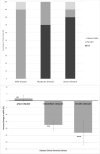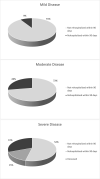Renal allograft function in kidney transplant recipients infected with SARS-CoV 2: An academic single center experience
- PMID: 34111211
- PMCID: PMC8191896
- DOI: 10.1371/journal.pone.0252979
Renal allograft function in kidney transplant recipients infected with SARS-CoV 2: An academic single center experience
Abstract
Background: Kidney transplant recipients are a unique cohort in regard to SARS-CoV 2 susceptibility and clinical course, owing to their immunosuppressed state and propensity for kidney injury. The primary purpose of this study is to ascertain if, in kidney transplant recipients, SARS-CoV 2 infection impacts long term renal allograft function.
Methods: This retrospective, single-center study reviewed 53 kidney transplant recipients with a positive SARS-CoV-2 PCR at NMH from January 1, 2020 to June 30, 2020.
Results: Change in eGFR from baseline kidney function prior to infection to 90 days after the first positive SARS-CoV 2 test was +1.76%, -17.5% and -23.16% the mild, moderate and severe disease groups respectively. There was a significant decline in kidney function in the moderate and severe disease cohorts as compared to the mild disease cohort, with respective p values of p = 0.0002 and p = 0.021. Relative to the mild disease cohort, the moderate and severe disease cohorts also demonstrated significantly increased risk of developing AKI (66%, 85%), both with p values of P = 0.0001.
Conclusions: Clinically severe SARS-CoV 2 infection is associated with greater risk of acute kidney injury and greater decline in renal allograft function at 90 days post infection, compared to mild disease.
Conflict of interest statement
The authors have declared that no competing interests exist.
Figures




Similar articles
-
The Effects of COVID-19 in Kidney Transplantation: Evidence From Tissue Pathology.Transplantation. 2025 Feb 1;109(2):352-361. doi: 10.1097/TP.0000000000005121. Epub 2025 Jan 20. Transplantation. 2025. PMID: 39020461
-
COVID-19 in Kidney Transplant Recipients: A Multicenter Experience from the First Two Waves of Pandemic.BMC Nephrol. 2022 May 12;23(1):183. doi: 10.1186/s12882-022-02784-w. BMC Nephrol. 2022. PMID: 35550025 Free PMC article.
-
SARS-CoV-2 Omicron infection in a cohort of hospitalized kidney transplant recipients: Risk factors of severity.Clin Nephrol. 2024 May;101(5):238-249. doi: 10.5414/CN111303. Clin Nephrol. 2024. PMID: 38497686
-
Renal involvement in COVID-19: focus on kidney transplant sector.Infection. 2021 Dec;49(6):1265-1275. doi: 10.1007/s15010-021-01706-6. Epub 2021 Oct 5. Infection. 2021. PMID: 34611792 Free PMC article. Review.
-
Pathogenesis of coronavirus disease 2019-associated kidney injury.Curr Opin Nephrol Hypertens. 2021 May 1;30(3):324-331. doi: 10.1097/MNH.0000000000000708. Curr Opin Nephrol Hypertens. 2021. PMID: 33767060 Review.
Cited by
-
COVID-19 and kidney disease: insights from epidemiology to inform clinical practice.Nat Rev Nephrol. 2022 Aug;18(8):485-498. doi: 10.1038/s41581-022-00570-3. Epub 2022 Apr 13. Nat Rev Nephrol. 2022. PMID: 35418695 Free PMC article. Review.
-
COVID-19 pandemic and worldwide organ transplantation: a population-based study.Lancet Public Health. 2021 Oct;6(10):e709-e719. doi: 10.1016/S2468-2667(21)00200-0. Epub 2021 Aug 30. Lancet Public Health. 2021. PMID: 34474014 Free PMC article.
-
Outcomes of Patients Receiving a Kidney Transplant or Remaining on the Transplant Waiting List at the Epicentre of the COVID-19 Pandemic in Europe: An Observational Comparative Study.Pathogens. 2022 Oct 3;11(10):1144. doi: 10.3390/pathogens11101144. Pathogens. 2022. PMID: 36297201 Free PMC article.
-
COVID-19 and solid organ transplantation: Finding the right balance.Transplant Rev (Orlando). 2022 Jul;36(3):100710. doi: 10.1016/j.trre.2022.100710. Epub 2022 Jul 4. Transplant Rev (Orlando). 2022. PMID: 35809422 Free PMC article.
-
Collapsing focal segmental glomerulosclerosis secondary to COVID-19: A systematic review and meta-analysis.Ann Med Surg (Lond). 2023 Feb 7;85(2):92-101. doi: 10.1097/MS9.0000000000000107. eCollection 2023 Feb. Ann Med Surg (Lond). 2023. PMID: 36845824 Free PMC article.
References
MeSH terms
LinkOut - more resources
Full Text Sources
Medical
Research Materials
Miscellaneous

